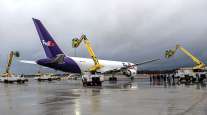Senior Reporter
Trucking Industry Expected to See Slower Growth in 2019

After a 2018 that saw record-setting levels of freight-hauling demand and driver pay as tonnage levels reached a 20-year high, the trucking industry is expected to remain strong in 2019 but undergo a bit of a cool-down, economists say.

Perry
“[Last year,] of course, was as good a year as the truck market has ever had — it was a record year in a number of ways,” Transport Futures Principal and Economist Noel Perry said during an interview on Transport Topics Radio, which is heard on SiriusXM Radio. “The spot market started the year at extraordinarily tight levels, and the contract market has been tight all year. So, it was a great year.”
He noted, however, that things trailed off as the year closed. “The fourth quarter was down enough in several categories to indicate we’re not going to sustain that peak performance in 2019.”
For the economy and the trucking industry, 2018 was spectacular. The U.S. Gross Domestic Product expanded at a 3.5% rate in the third quarter, and the December jobs report from the Bureau of Labor Statistics showed the economy added a robust 312,000 positions.
American Trucking Associations reported that, through November, the total freight hauled by for-hire truck drivers was 7.2% more than the first 11 months of 2017.
In an industry that ATA estimates is short more than 50,000 drivers, this kind of demand requires motor carriers to sometimes sweeten the pot to keep drivers happy. Last year, drivers benefited as many companies increased pay, improved bonuses and offered other benefits.

Last September, Chattanooga, Tenn.-based U.S. Xpress Enterprises announced the launch of its “Full Ride” program, in which the company will provide full college scholarships to drivers and family members.
U.S. Xpress ranks No. 21 on the Transport Topics list of the 100 largest for-hire carriers in North America. Also that month, Walmart Inc. announced it would double spending on driver recruitment. Walmart, which has about 6,500 trucks, ranks No. 3 on the Transport Topics list of 100 largest private carriers in North America.
Another company, Hudson, Ill.-based Nussbaum Transportation, said it was introducing an employee ownership plan, and that all of its employees would immediately own a stake in the company.
ATA is expected to announce updated figures on the driver shortage later this month. Meantime, the demand remains.
In December FTR Transportation Intelligence projected freight growth will start the year at more than 3% and then drop to 2% in the second half of 2019.

Ake
“The peak in the industry looked to be somewhere in that May-to-September period, where things were extremely hot and now, yes they’re off of peak. But starting 2019 we are in good shape,” FTR Vice President of Commercial Vehicles Don Ake told Transport Topics.
FTR said it is still standing by its forecasts for 2019, but it does have some concerns about the recent wild swings on Wall Street and the slowing of world economic growth, especially in China and Europe. Economists are also looking carefully at some factors that could hurt the economy and the trucking industry, most notably the trade dispute between the U.S. and China, the world’s No. 1 and No. 2 economies.
Tariffs of up to 25% were to be imposed on imported Chinese goods Jan. 1, but on Dec. 18, Treasury Secretary Steven Mnuchin announced that Washington and Beijing planned to engage in a follow-up round of trade negotiations beginning Jan. 7 to address outstanding issues, including a bilateral trade deficit and access for American companies to Chinese markets.
With continued strength in November, tonnage growth is on pace to be the best year since 1998. — American Trucking (@TRUCKINGdotORG) December 18, 2018
“There are two things that are working that make me feel this problem is going to go away,” said Perry. “First off, demand for manufactured goods in China has slowed. So they’re looking to make stuff for somebody. The other thing is that, of course, they send a lot more to us than we send to them. And therefore, if both sides put up the same level of tariffs, it hurts them a lot more than it would hurt us. So maybe the Chinese leaders have decided they should compromise.”
But Perry and Ake say for at least the first six to eight months of the year, the trucking economy will remain in solid shape.
“2019 looks to be an OK year, but people will feel in our business that it is not a good year, because they’re used to the wonderful things that happened in 2017 and especially 2018,” remarked Perry.
“The industry is still looking good going into 2019,” added Ake.


